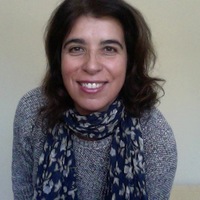
Lee Hangjun
Related Authors
Jihoon Kim
Chung Ang University
Jung Joon Lee
Rhode Island School of Design
Vered Maimon
Tel Aviv University
Ej Park
University of California, San Diego
Nicoletta Pireddu
Georgetown University
Seung-hoon Jeong
California State University Long Beach
Jeffrey Geiger
University of Essex
Margarida Medeiros
Faculdade de Ciências Sociais e Humanas - Universidade Nova de Lisboa
Joseph Jeon
University of California, Irvine
Teresa Mendes Flores
Faculdade de Ciências Sociais e Humanas - Universidade Nova de Lisboa
InterestsView All (7)










Uploads
Papers by Lee Hangjun
methods of expanded cinema, including manual and chemical processing of film stocks, improvisational realtime manipulation of projectors or filmstrips, and collaborations with avant-garde musicians—have been
presented in Korea, Canada, the UK, France, and Belgium. These numerous presentations during the last few years have not simply included venues for the screening of avant-garde films but also galleries. Given that they are intended to highlight the presence of the cinematic apparatus, spectators, and the projectionist within different contexts of performance and viewing,
Lee’s projects are also seen as pertaining to expanded cinema’s prolonged association with “liveness, ‘immediacy,’ an emphasis on ‘primary experience,’ and the directness of viewing.”
"일반적으로
게이트는 ‘공간으로 진입하기 위한 통로’이다. 영사기 속 게이트는 필름 스트립(film strip)의 연속된 프레임이 한 프레임씩 안정적으로 넘어가도록 고정시켜주고, 프레임의 경계를 형성한다. 스크린에 영사되는 이미지의 경계, 다시 말해 이미지의 범위와 비율이 게이트에 의해 결정된다. 영사기 속 게이트에 이상이 있거나 혹은 게이트를 제거할 때 발생하는 기계적 오류를 우리는 “필름이 흐른다.”라고 한다. 영사기 게이트는 극장에서 영화 공간으로 관객의 의식이 진입하는 통로 역할을 하며, 우리가 볼 수 있는 것과 없는 것, 또는 보아야 할 것과 보지 말아야 할 것을 규정한다. 호르헤 로렌소의 말처럼 ‹필름 누아르›에서 프레임의 경계는 결국 관객에 의해 결정되는 것이다."
Drafts by Lee Hangjun
I came to ruminate on this dormant episode and mull over its implications intensely after I watched/listened to Phantom School Army [Phantom hereafter]. South Korea’s trailblazing avantgarde filmmaker and performer Hangjun Lee’s most recent work to date, Phantom is a remarkable work of art as it blinds, if momentarily, viewers with a series of flashes while bombarding audiences with noise-induced sound blast. What’s more striking is that this literally vertiginous audiovisual performance work addresses Yeosu-Suncheon Rebellion (1948), one of South Korea’s dark historical traumas whose immediate aftermath (the number of casualties overall is estimated to reach 10,000) and long-term repercussions in effectively establishing the ‘red scare’ or anticommunism proved vital, or rather, lethal to many lives as well as the egalitarian imaginary in post-war South Korea.
To those who knew Lee’s work solely from the perspective of putatively ‘pure’ experimental vein, however “materialist” it aspires to be, this engagement with such a historic event could come as a surprise. Conversely, for those whom ‘experimental cinema’ means nothing less than a vacuous audiovisual acrobatics in the name of the so-called ‘aesthetic experiments’, the abovementioned description of Phantom alone serves to discredit its practical value: in what sense does this non-narrative performative film work relate to the actual historical event? Is this not another proof of artwork’s irrelevance to the so-called ‘real’ world?
Hence the following questions: how do these elements relate to one another? How does a performative film work reconcile its performative aesthetic dimension with the heavyweight historical trauma without sacrificing either pole?
methods of expanded cinema, including manual and chemical processing of film stocks, improvisational realtime manipulation of projectors or filmstrips, and collaborations with avant-garde musicians—have been
presented in Korea, Canada, the UK, France, and Belgium. These numerous presentations during the last few years have not simply included venues for the screening of avant-garde films but also galleries. Given that they are intended to highlight the presence of the cinematic apparatus, spectators, and the projectionist within different contexts of performance and viewing,
Lee’s projects are also seen as pertaining to expanded cinema’s prolonged association with “liveness, ‘immediacy,’ an emphasis on ‘primary experience,’ and the directness of viewing.”
"일반적으로
게이트는 ‘공간으로 진입하기 위한 통로’이다. 영사기 속 게이트는 필름 스트립(film strip)의 연속된 프레임이 한 프레임씩 안정적으로 넘어가도록 고정시켜주고, 프레임의 경계를 형성한다. 스크린에 영사되는 이미지의 경계, 다시 말해 이미지의 범위와 비율이 게이트에 의해 결정된다. 영사기 속 게이트에 이상이 있거나 혹은 게이트를 제거할 때 발생하는 기계적 오류를 우리는 “필름이 흐른다.”라고 한다. 영사기 게이트는 극장에서 영화 공간으로 관객의 의식이 진입하는 통로 역할을 하며, 우리가 볼 수 있는 것과 없는 것, 또는 보아야 할 것과 보지 말아야 할 것을 규정한다. 호르헤 로렌소의 말처럼 ‹필름 누아르›에서 프레임의 경계는 결국 관객에 의해 결정되는 것이다."
I came to ruminate on this dormant episode and mull over its implications intensely after I watched/listened to Phantom School Army [Phantom hereafter]. South Korea’s trailblazing avantgarde filmmaker and performer Hangjun Lee’s most recent work to date, Phantom is a remarkable work of art as it blinds, if momentarily, viewers with a series of flashes while bombarding audiences with noise-induced sound blast. What’s more striking is that this literally vertiginous audiovisual performance work addresses Yeosu-Suncheon Rebellion (1948), one of South Korea’s dark historical traumas whose immediate aftermath (the number of casualties overall is estimated to reach 10,000) and long-term repercussions in effectively establishing the ‘red scare’ or anticommunism proved vital, or rather, lethal to many lives as well as the egalitarian imaginary in post-war South Korea.
To those who knew Lee’s work solely from the perspective of putatively ‘pure’ experimental vein, however “materialist” it aspires to be, this engagement with such a historic event could come as a surprise. Conversely, for those whom ‘experimental cinema’ means nothing less than a vacuous audiovisual acrobatics in the name of the so-called ‘aesthetic experiments’, the abovementioned description of Phantom alone serves to discredit its practical value: in what sense does this non-narrative performative film work relate to the actual historical event? Is this not another proof of artwork’s irrelevance to the so-called ‘real’ world?
Hence the following questions: how do these elements relate to one another? How does a performative film work reconcile its performative aesthetic dimension with the heavyweight historical trauma without sacrificing either pole?